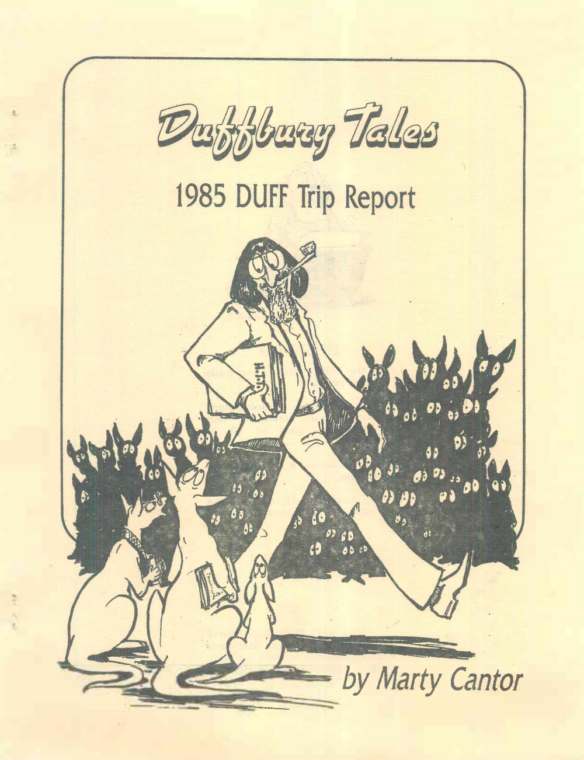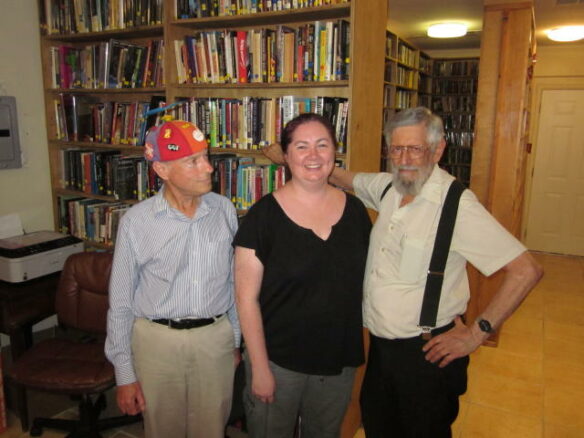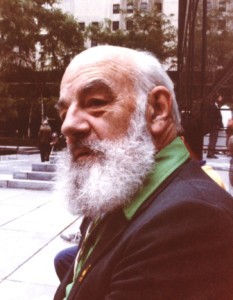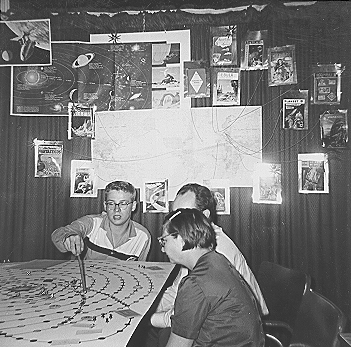(1) CLASSIC CAR WITH AN SFF PEDIGREE. J. Michael Straczysnki told Facebook readers he needs a taker for the late Harlan Ellison’s 1947 Packard.
For the last six months, we’ve talked to just about every vintage car company in existence about buying Harlan’s 1947 Packard, to no avail. It’s not an especially collectible car, not in great condition, not worth much on the market, and nobody we spoke to knew who Harlan was or felt that this added to its market value.
We need to get the car out of the garage where it’s been sitting, exposed to the elements, every day for almost ten years because the plan is to turn the open garage into an enclosed, on-site storage and work area to make it easier to work on the house, rotate out equipment, and store display cabinets and other items to be used for exhibitions. But I really don’t want to just sell it for parts because it hurts my heart.
Knowing Harlan, I think he’d want the Packard to end up in the hands of a fan who could appreciate it, look after it, maybe fix it up over time. Which brings me here. If there’s a stone Harlan fan who can arrange to have the car (safely) picked up and transported away, it’s yours.
(And to everyone looking on: please don’t send me suggestions or links or say “well, what about this company?” or “I think I know a guy” or “what about an SF museum somewhere” because we have spent half a year chasing that stuff down and come up empty every time. We have to start the process of transforming the garage into on-site storage and as a place for the contractors currently making repairs to the house to seek refuge from the bitter heat. It’s been a long, difficult and annoying process, with so many folks flaking out on us, so honestly, just don’t.)
Any takers? Serious only. Must be able to pick it up by no later than the end of August.
UPDATED TO ADD: Despite the very clear request not to post more dead-end solutions, true to the tradition of the Internet, people keep posting the very thing they’re being asked not to post. I don’t mean to be crotchety about it, but I don’t know how to express it any more clearly: the only posts here should be from folks interested in taking the car, so if we can keep the signal to noise ratio to a minimum that would be grand. Otherwise every time I get pinged with a notification and think, oh, good, we have someone who can take the car, I come back to…the opposite.
Harlan Ellison wrote about his love for that Packard here.
I’m sitting in my car, my car is a 1947 Packard. I got a current car. I drive that one, but I love the Packard. I love the Packard because it was built to run, built to last. You could hit this car with 200 small Japanese cars and they would be demolished into ashes. When I go past a grade school little kids have no idea what this car is. They have no idea it was made in 1947. They don’t even know there was a year called 1947. But they see this car go by and they give me that (thumbs up & OK signs) and that means they recognize something that is forever, like the pyramids….
(2) X NO LONGER MARKS THE SPOT. Charlie Jane Anders has pulled the plug on her X (formerly Twitter) account. It’s gone. “If you see me on Twitter, it’s not me”. She tells why another common strategy for leaving the platform wouldn’t work for her:
…. Many, many people have advised me to delete all of my tweets, lock my account, and simply stop tweeting. Their argument is that someone else could take my username and impersonate me, which feels like a real, serious issue — but if I leave my account inactive for long enough, Twitter will probably take my username away and let someone else take it in any case. So I apologize in advance to anyone who sees a fake Charlie Jane on Twitter and gets confused. It’s not me, I swear. (And that’s part of why I’m writing this newsletter: so people can point to it if there’s any confusion.)
I feel the need to make a clean break from Twitter at this point. After all of the proliferation of hate speech, and the random shutdowns of progressive accounts that challenge the owner’s rigid orthodoxy, I was already wanting to make a break for it. But after the latest scandals involving CSAM, I really feel as though I have no choice. And the “clean break” thing feels important — to be honest, I don’t entirely trust myself not to log in a month from now when I have something to announce, unless I delete the account entirely….
(3) CELEBRATE BRATMAN’S HALF-CENTURY OF SCHOLARSHIP. A collection of David Bratman’s nonfiction, Gifted Amateurs, has been released by the Mythopoeic Press.
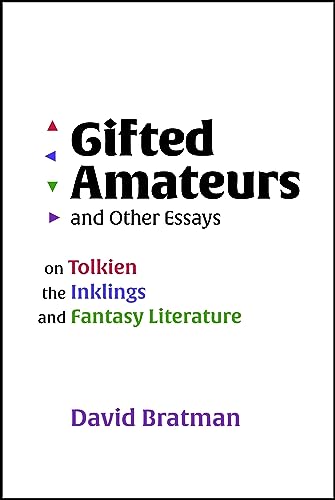
For more than four decades, David Bratman has established himself as a leading authority on J.R.R. Tolkien, the Inklings, and the enchanting realms of fantasy literature. Bratman’s scholarly articles, captivating Mythopoeic Conference presentations, and esteemed editorial work for the newsletter Mythprint and the journal Tolkien Studies: An Annual Scholarly Review have solidified his expertise. Now, in celebration of his profound contributions and recent distinction as the Scholar Guest of Honor at Mythcon 52, the Mythopoeic Press proudly presents Gifted Amateurs and Other Essays, an extraordinary collection of some of Bratman’s most insightful, engaging, and intellectually stimulating works.
Within these pages, discover the untold stories behind the “Top Ten Rejected Plot Twists from The Lord of the Rings,” unravel the religious themes woven throughout Middle-earth, and delve into the surprising origins of hobbit names. Guided by Bratman’s unwavering curiosity and scholarly passion, explore the fascinating history of the Inklings and how they connect to the boundless expanse of the Pacific Ocean, unearth the dramatic works of Lord Dunsany and the overlooked masterpiece of Mervyn Peake, and revel in the mythopoeic genius of Roger Zelazny. Seamlessly blending scholarship and entertainment, Gifted Amateurs and Other Essays invites readers on a journey that illuminates the true essence and enduring power of mythopoeic storytelling.
David Bratman has been writing Tolkien scholarship for nearly 50 years. He’s been co-editor of Tolkien Studies: An Annual Scholarly Review since 2013 and has edited its annual “Year’s Work in Tolkien Studies” since 2004. In addition to contributing to Tolkien scholarship, Bratman has published works on Charles Williams, C.S. Lewis, Ursula Le Guin, Mervyn Peake, Neil Gaiman, and others. Now a retired academic librarian, Bratman also was editor of the Mythopoeic Society’s members’ bulletin Mythprint for 15 years and worked on many Mythopoeic Conferences, including serving twice as chair.
(4) SDCC SOUVENIR BOOK. The 2023 San Diego Comi-Con souvenir book can be downloaded as a free PDF here.
(5) WANT TO BE A SPSFC JUDGE? The Self-Published Science Fiction Competition is recruiting judges for its third season. Apply here.
(6) YEARS PASS AND THESE ARE STILL LIVE ISSUES. [Item by Mike Kennedy.] SAG-AFTRA and producers are still at odds over many things. But, at least they have seemingly agreed to end the large majority of paintdowns and wiggings.
Wait, what?
“Ending One of the Last Vestiges of Blackface in Hollywood” in Rolling Stone.
As SAG strikes, stunt performers have proposed one thing the union and studios can agree on: a new process to end controversial “paintdowns” and “wiggings”
Actor Jason George was a few years into his career when he secured his first starring role in a movie. It was the early 2000s, and he’d been cast as a co-lead in a mountain climbing flick called The Climb. He was excited for the prospect of a break until he walked into a trailer one day and saw a white man “wearing my wardrobe, my helmet, my climbing harness, and they’re putting makeup on him to make him look like me.”
George, who is Black, was stunned.
“I did a double take — if you’d shot it for a movie, [my reaction] would’ve been too much, too big,” he tells Rolling Stone. “I stepped out to make sure I was in the right place, came back in, and said, ‘What is happening?’ And they said, ‘This is your stunt double.’”
What George had walked in on was a “paintdown.” It wasn’t blackface in the traditional sense of a minstrel show, but it was also definitely blackface. One of Hollywood’s many seedy little secrets, a paintdown is when the skin of a white stunt performer is darkened so they can double for an actor of color — rather than just hiring a stunt performer of the same ethnicity….
In the 20-odd years since, paintdowns and “wiggings” — a similar practice where, instead of hiring a stuntwoman, a man is dressed up to double a woman — have been on the decline, but they’re far from eradicated….
(7) A LITTLE MISTAKE. [Item by Kevin Hogan.] I always start my Hugo ballot early, based on what I nominated. In case I’m abducted by aliens, at least my initial preferences will be taken into account.
The website itself is nicely done, and the ranking of choices is easy enough. No way to accidentally rank multiple entries the same number with a drag and drop system.
I feel that the English proofreading on the nominees might need another pass, though. Unless Rachel Hartman truly is the secret 7th member of Monty Python.

Editor’s note: In case that’s too hard to read, we’re talking about Lodestone Award finalist Rachel Hartman’s In the Serpent’s Wake. When I voted today I copied the Chinese characters for Hartman’s work and ran them through Google Translate. It returned “Monty Python – Rachel Hartman (Random Children’s Books)” in English. The self-same Chinese text is part of the 2023 Hugo finalists press release.
(8) ROLL BACK THE RED CARPET. The New York Times is reporting “With Actors on Strike, Sony Pushes Big Releases to 2024”.
…Sony Pictures Entertainment on Friday pushed back the release of two major films that had been set to arrive in theaters by the end of the year — the Marvel Comics-based “Kraven the Hunter” and a sequel to “Ghostbusters: Afterlife.”
In addition, Sony is postponing some of its big 2024 releases. “Spider-Man: Beyond the Spider-Verse,” is no longer on track for a March premiere, and a new “Karate Kid” will no longer arrive in June.
Until now, the 2023 theatrical release schedule had been left relatively unscathed by the actors’ strike, which started on July 14. But other studios are likely to follow Sony’s lead. Warner Bros. has been debating whether to postpone “Dune: Part Two,” which is supposed to arrive in theaters on Nov. 3. “Aquaman and the Lost Kingdom,” a big-budget superhero sequel, and “The Color Purple,” based on the Broadway musical, are among other 2023 holiday-season movies that could be delayed….
(9) BO GOLDMAN (1932-2023.) [Item by Mike Kennedy.] Bo Goldman is probably best known as the screenwriter for One Flew Over The Cuckoo’s Nest, but many of his films received acclaim. He won two Oscars (for Cuckoo’s Nest plus Melvin and Howard) and was nominated for a third (for Scent of a Woman). Goldman died July 25. Read Variety’s tribute: “Bo Goldman, Oscar-Winning Writer of ‘One Flew Over the Cuckoo’s Nest’ Script, Dies at 90”.
His only completed and credited genre work appears to be the script for Meet Joe Black (1998)—starring Brad Pitt as Joe Black, aka Death. He did also do uncredited script revisions for 1990’s Dick Tracy.
In an alternate reality, we could’ve seen Goldman’s take on the King Kong story. In 1975 he wrote a script for a Universal film, to be called The Legend of King Kong. It went unproduced after Paramount and Dino DeLaurentis sued in favor of their own 1976 release of King Kong. (Source: IMDb, Trivia section of his entry.)
Goldman is also credited as one of the sources for a fan-produced King Kong film from 2016.
(10) TODAY’S BIRTHDAYS.
[Compiled by Cat Eldridge.]
- Born July 29, 1888 — Farnsworth Wright. Editor of Weird Tales, editing an amazing 179 issues from November 1924–March 1940. Mike Ashley in EoSF says, “Wright developed WT from a relatively routine horror pulp magazine to create what has become a legend.” His own genre fiction is generally considered undistinguished. He also edited during the Thirties, Oriental Stories and The Magic Carpet. The work available digitally is a poem, “After Two Nights of the Ear-ache”. He was nominated at Loncon 3 for a Best Editor Retro Hugo. (Died 1940.)
- Born July 29, 1907 — Melvin Belli. Sole genre role is that of Gorgan (also known as the “Friendly Angel”) in the Star Trek “And the Children Shall Lead” episode. Koenig objected to his playing this role believing the role should have gone to someone who was an actor. (Died 1996.)
- Born July 29, 1915 — Kay Dick. Author of two genre novels, The Mandrake Root and At Close of Eve, plus a collection, The Uncertain Element: An Anthology of Fanta. She is known in Britain for campaigning successfully for the introduction of the Public Lending Right which pays royalties to authors when their books are borrowed from public libraries. They which may or may not be genre is her only work available at the usual suspects. (Died 2001.)
- Born July 29, 1927 — Jean E. Karl. Founder of Atheneum Children’s Books, where she edited Ursula K Le Guin’s early Earthsea novels and Susan Cooper’s The Dark Is Rising series. An SF author as well for children and young adults, she wrote The Turning Place collection and three novels, Beloved Benjamin is Waiting, But We are Not of Earth and Strange Tomorrow. (Died 2000.)
- Born July 29, 1941 — David Warner. Being Lysander in that A Midsummer Night’s Dream was his first genre role. I’m going to do just highlights after that as he’s got far too extensive a genre history to list everything. So he’s been A Most Delightful Evil in Time Bandits, Jack the Ripper in Time After Time, Ed Dillinger / Sark In Tron, Father in The Company of Wolves, Chancellor Gorkon in Star Trek VI: The Undiscovered Country, The Creature in Frankenstein, voice of Ra’s al Ghul on Batman: The Animated Series and Abraham Van Helsing on Penny Dreadful. (Died 2022.)
- Born July 29, 1955 — Dave Stevens. American illustrator and comics artist. He created The Rocketeer comic book and film character. It’s worth noting that he assisted Russ Manning on the Star Wars newspaper strip and worked on the storyboards for Raiders of the Lost Ark. The Rocketeer film was nominated for a Hugo at MagiCon which was the year Terminator 2: Judgment Day won. (Died 2008.)
- Born July 29, 1956 — Chitra Banerjee Divakaruni, 67. Author of the India set magical realist The Brotherhood of the Conch series. She also has three one-off novels, The Palace of Illusions, The Mistress of Spices, and The Forest of Enchantments.
(11) VALHALLA FOR FANZINES. Thanks to Heath Row, the late Marty Cantor’s 54 boxes have been delivered to the Eaton Collection at UC Riverside. See photos on FB.
Today a friend and I loaded a rented van with 54 boxes of science fiction fanzines and amateur press association bundles and mailings to donate to the Eaton collection at UC Riverside. The collection spans 1975 to the present day. It is a veritable treasure trove.
(12) A JOLLY PAIR OF FRIGHTENERS. Once upon a time in 1968, Boris Karloff and Vincent Price sang a duet on the Red Skelton Hour.
(13) IS THAT WATER THEY SEE? [Item by SF Concatenation’s Jonathan Cowie.] There’s a pre-print just up on Nature in which an international collaboration of western European based astronomers has reported the detection of water in the terrestrial zone of a planet forming star system.
PDS 70 (V1032 Centauri) is a very young T Tauri star in the constellation Centaurus. Located 370 light-years (110 parsecs) from Earth, it has a mass of 0.76 M☉ and is approximately 5.4 million years old. The star has a protoplanetary disk containing two very early exoplanets, named PDS 70b and PDS 70c, which have previously been directly imaged by the European Southern Observatory’s Very Large Telescope. PDS 70b was the first confirmed protoplanet to be directly imaged.

Terrestrial and sub-Neptune planets are expected to form in the inner (less than 10 AU – 1 AU being the distance from Earth to the Sun) regions of protoplanetary disks.
The European astronomers’ findings show water in the inner disk of PDS 70. This implies that potential terrestrial planets forming therein have access to a water reservoir.
OK, before we get too excited 1) the edge of the detection is 1 AU (the distance from the Earth to our Sun) and 2) PDS 70 is smaller, hence cooler, K-type star than our Sun and so the habitable zone would closer in to the star than in the Solar System: further in than the 1AU detection limit.
OK, we can get a little excited. There has been a fair bit about water in proto-planetary systems recently and the over-all picture emerging does seem that it is likely that water might exist early in star systems’ lives in the habitable zone and not — as it is today either already on planets or alternatively on small bodies beyond planetary snow or frost line which in our system is beyond Jupiter. The reason it could exists so close in — as the pre-print alludes — is because proto-planetary systems have not yet has a star with solar wind clearing out all the interplanetary dust and gas: that came later.
Until recently, the conventional theory was that the Earth (and Mars) had water transported to it from beyond the snow line. by the more abundant comets in the early Solar system. Possibly these comets were driven inward by a migrating Jupiter to a more stable orbit, so providing the inner system with a late veneer or heavy bombardment of volatile rich comets. The picture that emerges is that water is more common — if not universal — in very early planetary systems and so planets forming there will have water.
The pre-print is Perotti, G. et al (2023) Water in the terrestrial planet-forming zone of the PDS 70 disk. Nature, vol. to be determined, pages to be determined.
(14) VASTER THAN EMPIRES. The Smithsonian discusses the challenges of “Preserving Launch Infrastructure” at the National Air and Space Museum.
Launching a rocket is a complex operation, requiring personnel, equipment, and infrastructure. Space agencies and companies around the world, therefore, build giant ground systems to support launches. One of the largest and best-known launch complexes is Launch Complex 39 (LC 39), which NASA has used at Florida’s Kennedy Space Center to stack and launch rockets for the Apollo, Skylab, Space Shuttle, and Artemis programs, among others.
All these programs have relied on a similar method of assembly. Apollo and Skylab’s Saturn V and Saturn IB, the Space Shuttle’s Space Transportation System, and Artemis’ Space Launch System (SLS) have all had their final construction inside the massive Vehicle Assembly Building (VAB). At 525 feet tall, the VAB is one of the largest buildings by volume in the world. Stacking the launch vehicle inside protects it from weather, including Florida’s frequent storms….
Both the mobile launch platforms and the CTs are enormous, meaning that they are both much too large to fit inside either of the National Air and Space Museum’s two locations. Even NASA does not have enough space to store the MLPs now that they will not be used for Artemis. At the same time, both structures are integral to the histories of three space programs. How can the Museum collect artifacts to tell this history? One way is through preserving representative components that can speak to the history, use, and scale of these pieces of infrastructure.
From the Crawler Transporter, the Museum’s collection boasts two tread shoes. Seeing the shoes up close gives a sense of scale. Additionally, it is possible to see that these are shoes that have been used. Their wear and tear speaks to the heavy load that the CT carries as it moves the vehicle to the launch pad….
(15) VIDEO OF THE DAY. How It Should Have Ended works out the correct finish for “Guardians of the Galaxy Volume 3”. Actually, several correct finishes. Take your pick!
How Guardians of the Galaxy Volume 3 Should Have Ended. Starlord remembers his boots, The High Evolutionary visits the Villain Pub, The Guardians visit the Super Cafe, and Rocket Raccoon saves his friends.
[Thanks to Andrew Porter, John King Tarpinian, Chris Barkley, Kevin Hogan, Michael Toman, Cat Eldridge, SF Concatenation’s Jonathan Cowie, and Mike Kennedy for some of these stories. Title credit belongs to File 770 contributing editor of the day P J Evans.]



